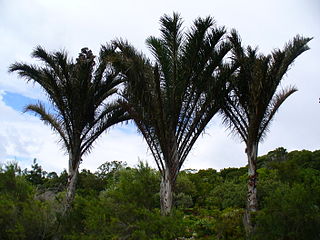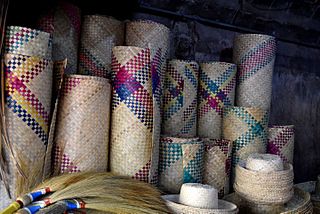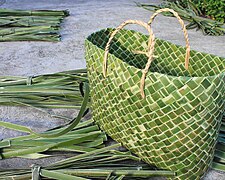
Abacá (Spanish), Musa textilis, is a species of banana endemic to the Philippines. The plant grows to 13–22 feet (4.0–6.7 m), and averages about 12 feet (3.7 m). The plant, also known as Manila hemp, has great economic importance, being harvested for its fiber, also called Manila hemp, extracted from the leaf-stems.

Raffia palms are members of the genus Raphia. The Malagasy name rafia is derived from fia "to squeeze juice". The genus contains about twenty species of palms native to tropical regions of Africa, and especially Madagascar, with one species also occurring in Central and South America. R. taedigera is the source of raffia fibers, which are the veins of the leaves, and this species produces a fruit called "brazilia pods", "uxi nuts" or "uxi pods".

Pandanus is a genus of monocots with about 578 accepted species. They are palm-like, dioecious trees and shrubs native to the Old World tropics and subtropics. The greatest number of species are found in Madagascar and Malaysia. Common names include pandan, screw palm and screw pine. They are classified in the order Pandanales, family Pandanaceae.

Corypha or the gebang palm, buri palm or talipot palm is a genus of palms, native to India, Malaysia, Indonesia, the Philippines, New Guinea and northeastern Australia. They are fan palms, and the leaves have a long petiole terminating in a rounded fan of numerous leaflets.

Pandanus tectorius is a species of Pandanus (screwpine) that is native to Malesia, Papuasia, eastern Australia, and the Pacific Islands. It grows in the coastal lowlands typically near the edge of the ocean. Common names in English include thatch screwpine, Tahitian screwpine, hala tree and pandanus. The fruit is edible and sometimes known as hala fruit.

Borassus is a genus of five species of fan palms, native to tropical regions of Africa, Asia, and Papua New Guinea.

Arenga pinnata is an economically important feather palm native to tropical Asia, from eastern India east to Malaysia, Indonesia, and the Philippines in the east. Common names include sugar palm, areng palm, black sugar palm, and kaong palm, among other names.

Straw plaiting is a method of manufacturing textiles by braiding straw and the industry that surrounds the craft of producing these straw manufactures. Straw is plaited to produce products including straw hats and ornaments, and the process is undertaken in a number of locations worldwide.

Pandanus conoideus is a plant in the Pandanus family from New Guinea. Its fruit is eaten in Papua New Guinea and Papua, Indonesia. The fruit has several names: marata, marita in Papua New Guinea local language, kuansu in Dani of Wamena or buah merah in common Indonesian. The fruit is typically prepared by splitting it, wrapping it in leaves, and cooking it in an earth oven, making it a traditional delicacy.

Pandanus spiralis is a small tree in the family Pandanaceae native to northern Australia. It is commonly called pandanus, spring pandanus, screw palm or screw pine, although it is neither a palm nor a pine.

Pandanus utilis, the common screwpine is, despite its name, a monocot and not a pine. It is native to Madagascar and naturalised in Mauritius and the Seychelles.
Lauhala, lau meaning "leaf" in the Hawaiian language, refers to the leaves of the hala tree (Pandanus tectorius).

A baníg is a traditional handwoven mat of the Philippines predominantly used as a sleeping mat or a floor mat. Depending on the region of the Philippines, the mat is made of buri (palm), pandanus or reed leaves. The leaves are dried, usually dyed, then cut into strips and woven into mats, which may be plain or intricate.

Saba banana is a triploid hybrid (ABB) banana cultivar originating from the Philippines. It is primarily a cooking banana, though it can also be eaten raw. It is one of the most important banana varieties in Philippine cuisine. It is also sometimes known as the "cardaba banana", though the latter name is more correctly applied to the cardava, a very similar cultivar also classified within the saba subgroup.

Astrocaryum standleyanum is a species of palm known by many common names, including chumba wumba, black palm, chonta, chontadura, coquillo, palma negra, pejibaye de montaña, güerre, güérregue, güinul, mocora, pucaishchi (Chachi), and chunga (Emberá). It is native to Central and South America, where its distribution extends from Nicaragua to Ecuador. It is most common in central Panama, even becoming abundant in the tropical forests around the Panama Canal, but in general it is not a common plant.

Raphia farinifera is a tropical African palm tree occurring in lowland riparian and swamp forest, also around human habitations and cultivated locations, on stream banks and other moist situations at altitudes of 50–1000 m. Found in Angola, Benin, Burkina, Cameroon, Gambia, Ghana, Guinea, Ivory Coast, Kenya, Madagascar, Malawi, Mauritius, Mozambique, Nigeria, Réunion, Senegal, Seychelles, Sierra Leone, Tanzania, Togo, Uganda, Zambia and Zimbabwe, and naturalised in east lowlands of Madagascar. Its generic epithet is derived from raphis = 'needle', probably in reference to the 4 mm long yellowish spines on the margins and main veins of the leaflets. The specific name refers to a type of starchy flour obtained from the trunk pith – farina = 'starch', fera = 'bearing'.

Pandanus dubius, commonly known as bakong or knob-fruited screwpine, is a species of Pandanus (screwpine) native to Island Southeast Asia, New Guinea, and the Western Pacific islands, and possibly also to the Andaman and Nicobar Islands.
Pandanus whitmeeanus, commonly known as the Samoan pandanus, is a species of Pandanus (screwpine) believed to be native to Vanuatu. It has been introduced to Samoa, Tonga, the Cook Islands, and the Hoorn Islands by Austronesian voyagers. It is also known in Samoan and Tongan as ‘ara ‘āmoa or paogo.
Pandanus concretus is a dioecious tree in the screwpine genus. It is endemic to Madagascar, found in Toliara province. Pandanus concretus is the accepted name, but it has also been called Pandanus centrifugalis, P. dauphinensis, P. erectus and P. madagascarensis.

Pandanus solms-laubachii, commonly known as the swamp pandan, is a small tree in the family Pandanaceae which occurs in northeastern Queensland and possibly in Papua New Guinea. It is closely related to both Pandanus gemmifer and Pandanus grayorum.
























